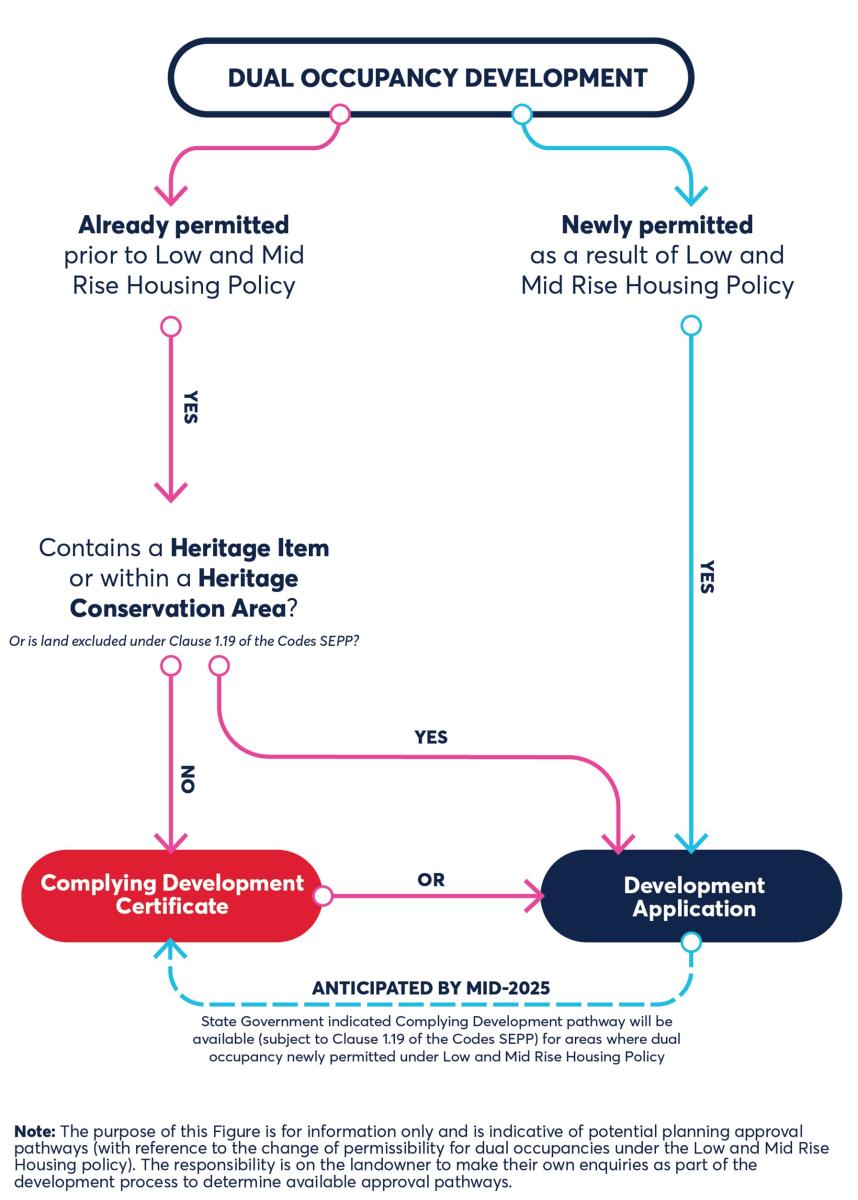NSW Government Low-and Mid-Rise Housing Policy
The Low and Mid Rise Housing Policy (LMR Policy) is a NSW Government policy that intends to increase housing supply and diversity across NSW. It has changed the planning rules within an 800-metre walking distance of identified town centres and stations to allow low and mid-rise housing in R2 Low Density, R3 Medium Density, and R4 High Density residential zones:
- ‘Low-rise’ housing is generally 1–2 storeys and includes dual occupancies (2 dwellings on the same lot), terraces, townhouses, and low-rise apartment buildings (formerly called Manor houses).
- ‘Mid-rise’ housing is generally a 3–6 storey apartment buildings or shop top housing.
The policy forms ‘Chapter 6 Low and Mid-rise housing’ in the State Environmental Planning Policy (Housing) 2021 (Housing SEPP 2021).
Where does it apply in the City of Parramatta?
The LMR policy applies to the following stations and town centres:
- Eastwood (split with Ryde Council)
- Epping
- Carlingford
- Granville (split with Cumberland Council)
- Northmead
- Westmead (split with Cumberland Council)
- Winston Hills (split with The Hills Council)
You can view an indicative map of the low and mid-rise housing areas on the Department of Planning, Housing and Infrastructure’s website, and read more about how the Low and Mid-rise housing areas were selected here.
What does it mean for the City of Parramatta?
The LMR Policy changes the housing types that Council typically allows in our Local Environmental Plan in residential zones within 800m walking distance from these stations and town centres. ‘Low-rise’ and ‘Mid-rise’ housing types (see above) are now allowed with development approval in the R2 Low Density, R3 Medium Density, and R4 High Density residential zones.
The LMR Policy also applies non-discretionary development standards (or ‘rules’) for the housing types allowed under the LMR Policy. For example, the minimum size and width of a site to allow development, and how many storeys the building can be.
If a development application meets these standards (or ‘rules’), the application cannot be refused on these grounds. These rules do not apply to land that is excluded from the LMR Policy (refer to FAQ Question 5).
Where to find out more information
More detail on the NSW Government Low and Mid-Rise Policy can be found on the Low and Mid Rise Housing Policy page on the Department of Planning, Housing and Infrastructure’s website.
The below ‘Frequently Asked Questions’ have been developed to help our community understand how the policy applies in the City of Parramatta. These can be read alongside the State Government’s 'Frequently Asked Questions'.
-
The NSW Government’s LMR Policy took effect in two (2) stages:
- Stage 1 commenced on 1 July 2024 - Permitted dual occupancy and semi-detached homes in R2 Low Density Residential zones across all of NSW.
- Stage 2 commenced on 28 February 2025 – Introduced changes to planning controls within a 800m walking distance of identified town centres and stations.
-
The LMR Policy was implemented in stages and applies to different residential land within the City of Parramatta.
Stage 1 of the LMR Policy applies if your property is:
- Zoned R2 Low Density Residential; and
- Prohibited for dual occupancy under the Parramatta LEP 2023
This affects parts of Epping, Eastwood, Beecroft, Carlingford, Winston Hills, Harris Park, Parramatta and North Parramatta shown yellow on the map.
Additional FAQs relating to dual occupancy are included below.
Stage 2 of the LMR Policy could apply if your property is:
- Zoned R2 Low Density, R3 Medium Density, or R4 High Density Residential; and
- Located within 800m walking distance of the following stations and town centres:
- Eastwood (split with Ryde Council)
- Epping
- Carlingford
- Granville (split with Cumberland Council)
- Northmead
- Westmead (split with Cumberland Council)
- Winston Hills (split with The Hills Council)
An Indicative Map has been prepared by the State Government and is used to indicate where the LMR Policy applies.
-
The land use zoning of all land within the City of Parramatta is contained within the Parramatta Local Environmental Plan 2023 (PLEP 2023).
To access the maps that contain the planning information, you can visit the following:
- Digital mapping for PLEP 2023 - This is the legal version of the maps and should be relied on when making planning decisions.
- Department’s mapping viewer – This is a quick way to search your property address and identify the zoning of your property, and other planning information.
More information about the digital mapping of the PLEP 2023 can be found here.
-
Walking distance is measured from the site to the nearest station entrance or the nearest edge of the mapped town centre along a publicly accessible walking route. Walking distance is defined in the NSW legislation as the shortest distance between 2 points measured along a route that may be safely walked by a pedestrian using, as far as reasonably practicable, public footpaths and pedestrian crossings.
When development applications are made, the applicant will need to demonstrate that the site is within 800 metres walking distance from the nearest edge of a town centre or the entrance to one of the stations for the site to be considered within a low and mid-rise housing area. For further information, refer to Department’s FAQ webpage.
-
Both Stage 1 – permitting dual occupancies and Stage 2 – permitting low and mid-rise housing of the LMR policy does not apply to land that is affected by certain hazards and constraints. Detail on LMR policy exclusions is available on the State Government’s website.
In the City of Parramatta, this includes sites that are:
- Heritage items
- Bushfire prone
You can see whether your property is a Heritage Item or Bushfire Prone using the NSW Spatial Viewer. For Heritage Items, select ‘Principal Planning Layers’, ‘Heritage’, and then ‘Heritage Map’ from the dropdown. For Bushfire Prone land, select the ‘Hazard’ and ‘Bushfire Prone Land’ from the dropdown.
Properties within a Heritage Conservation Area are not excluded from the LMR policy application. However, heritage considerations will still need to be addressed as part of any future development application for any of the low and mid-rise housing types under Clause 5.10 Heritage Conservation of the Parramatta LEP.
Dual occupancies and heritage items
Where dual occupancies were newly permitted in the Parramatta LEP 2023 (see mapped yellow areas) under Stage 1 of the LMR Policy (see Question 2), dual occupancies are still NOT permitted on a heritage listed property. These will continue to remain prohibited.
Where dual occupancies were already permitted in the Parramatta LEP 2023 prior to Stage 1 of the LMR Policy, dual occupancies continue to be permitted on properties with heritage items (other than in the prohibition areas shown in yellow on the map). The PLEP 2023 makes specific allowances for dual occupancies to be detached (i.e. two on the same property, but not attached) in the case of a heritage item; or for development within the South Parramatta Heritage Conservation Area. In both instances, the existing heritage items would need to be retained to enable any further development on the site.
-
There are different approval pathways for dual occupancy development as outlined in the Figure below. There are circumstances that exclude certain types of land from using a Complying Development Certificate process. Clause 1.19 of SEPP (Exempt and Complying Development Codes) 2008 describes land that is excluded from the Complying Development Certificate process.
Figure. Indicative approval process for a dual occupancy.

-
The State Government introduced new ‘rules’ referred to as non-discretionary development standards for the housing types allowed under the LMR Policy. These include:
- Height of Building – how tall the building can be.
- Floor Space Ratio – how many square metres the building can be.
- Minimum Lot Size & Minimum Lot width – how big and wide a site needs to be to be developed for the different housing types.
- Maximum car parking spaces – how many cars need to fit on the site.
These non-discretionary ‘rules’ only apply within the Low and Mid-Rise Housing Areas identified as part of Stage 2 of the LMR Policy (see Question 2 for the areas in the City of Parramatta).
If a development application is lodged within a Low and Mid-Rise Housing Area for one of the low and mid-rise housing types, and meets these rules, then the application cannot be refused on these grounds.
Non-discretionary subdivision standards have also been introduced for dual occupancies and terraces within the Low and Mid-Rise Housing Areas where subdivision was already permitted via a LEP. The Low and Mid-Rise Housing Policy in Chapter 6 of the Housing SEPP 2021 does not expand the permissibility of subdivision; rather it has introduced development standards for where subdivision was already permitted with development consent within the Low and Mid-Rise Housing Areas.
What if the controls in the LEP or DCP are greater than the LMR policy?
If the development standard in Parramatta LEP is higher than the development standard in the LMR Policy, then the development application can utilise this higher control. For example, if Council’s LEP FSR is 1.99:1 and Chapter 6 of the Housing SEPP 2021 FSR is 1.5:1, then Council’s FSR control on the LEP Map can be used.
For details on the rules, please visit the Department’s website.
In addition, these rules only apply to land within a Low and Mid-Rise Housing Area (including land within a Heritage Conservation Area, but excluding sites with Heritage Items). All other land within the City of Parramatta are subject to the development standards within the Parramatta LEP 2023 and Parramatta DCP 2023. This includes an application for a dual occupancy on land outside of a Low and Mid-Rise Housing Area, even if it was newly permitted under Stage 1 of the LMR Policy (see Question 2).
-
The following types of low-rise housing types are now allowed with development approval in the R2 Low Density Zone within a Low and Mid-Rise (LMR) area if the land meets the following minimum requirements:
- Dual occupancies, if the land is 450sqm and is 12m wide.
- Town houses (multi-dwelling housing), the land is 600sqm and is 12m wide.
- Terraces, the land is 500sqm and is 18m wide.
- Low-rise apartment buildings, the land is 500sqm and is 12m wide.
What has changed?
While dual occupancies were allowed in most R2 Low Density Residential areas under the Parramatta LEP 2023, the other low-rise housing types (town houses, terraces, and low-rise apartment buildings) were not allowed in the R2 Low Density zone under Council’s LEP.
Further, the land size and frontage requirements for a dual occupancy has been reduced from a minimum 600sqm and 15m wide under Parramatta LEP 2023, to a minimum 450sqm and 12m wide under the LMR Housing Policy.
What is the size of the development?
The low-rise housing types are generally 1-2 storeys.
To view a summary of the new rules for the low-rise housing types, visit the State Government’s website.
-
The following types of low-rise and mid-rise housing types are now allowed with development approval in the R3 Medium Density Zone within a Low and Mid-Rise (LMR) area if the land meets the following requirements:
- All low-rise housing types permitted in the R2 Low Density zone (see Question 8)
- Mid-rise apartment buildings.
Compared to the low-rise housing types, the Low and Mid-Rise Housing Policy does not include a minimum site size or width for mid-rise apartment buildings. The Apartment Design Guide will apply to guide the built form of mid-rise apartment buildings.
What has changed?
While all low-rise housing types (dual occupancies, terraces, townhouses, and low-rise apartment buildings (previously called a manor house) were allowed within R3 Medium Density Residential areas under Parramatta LEP 2023, mid-rise apartments were not allowed in the R3 zone under Council’s LEP.
What is the size of the development?
Low-rise housing types are generally 1-2 storeys (as outlined in Question 8).
Mid-rise apartment buildings can be 3-6 storeys depending on whether the R3 zoned land is located within 800-400m or within 0-400m of the seven identified stations and centres within the City of Parramatta.
To view a summary of the new non-discretionary development standards for the low-rise and mid-rise housing types (including the differences for land within 0-400m and 400-800m of a identified station and centre), visit the State Government’s website.
-
All low and mid-rise housing types permitted in the R2 Low Density and R3 Medium Density Residential zones are permitted in the R4 High Density Zone (see Questions 8 and 9).
What has changed?
There is no change to the types of housing that is allowed within the R4 High Density Residential zone – the Parramatta LEP 2023 already allowed with approval dual occupancies, terraces, townhouses, and low-rise and mid-rise apartment buildings.
The LMR policy has changed the allowable size and scale of mid-rise apartment buildings that can be built on land zoned R4 High Density within Low and Mid-Rise Housing Areas. The size and scale vary from what is allowed in the Parramatta LEP 2023.
What is the size of the development?
Low-rise housing types are generally 1-2 storeys (as outlined in Question 8).
Mid-rise apartment buildings can be 3-6 storeys depending on whether the R4 zoned land is located within 800-400m or within 0-400m of the seven identified stations and centres within the City of Parramatta. This is the same as R3 zoned land (see Question 9).
In some parts of the Low and Mid-Rise Housing Areas, the impacts of the LMR Policy on R4 High Density Residential land include:
- increasing the building height and Floor Space Ratio (FSR) compared to what is allowed under the Parramatta LEP 2023. In this instance, applicants can apply for a greater building height and FSR in a development application.
- decreasing the building height and FSR compared to what is allowed under the Parramatta LEP 2023. In this instance, applicants can continue to apply Council’s building height and FSR control in a development application.
To view a summary of the new non-discretionary development standards for the low-rise and mid-rise housing types (including the differences for land within 0-400m and 400-800m of an identified transport hub and town centre), visit the State Government’s website.
-
Low and mid-rise housing types developed under the Low and Mid-Rise Housing Policy within Chapter 6 of the Housing SEPP (2021) within a residential zone may be eligible for a bonus if the development provides dedicated affordable housing.
Visit the State Government’s website for more information.
-
The Low and Mid-Rise Housing Policy introduces the Tree Canopy Guide for Low and Mid Rise Housing. The Tree Canopy Guide needs to be considered in the development application process for housing types proposed within a Low and Mid-Rise Housing Area.
-
The development standards within the Parramatta LEP 2023 and Chapter 6 of the Housing SEPP 2021 (which applies the Low and Mid Rise Housing Policy) apply concurrently to residential zoned land (i.e. R2 Low Density, R3 Medium Density, and R4 High Density) within the seven Low and Mid Rise Areas within the City of Parramatta.
It is not suitable to make any changes to the existing LEP maps within the Parramatta LEP 2023 because if a landowner wants to redevelop their site for a development type that is not identified in the Low and Mid-Rise Housing Policy, the proposal must be consistent with the development standards in Parramatta LEP 2023.
Note.
Parramatta LEP 2023 means Parramatta Local Environmental Plan 2023.
Parramatta DCP 2023 means Parramatta Development Control Plan 2023.
Housing SEPP 2021 means State Environmental Planning Policy (Housing) 2021.
DCP means Development Control Plan.
LEP means Local Environmental Plan.
SEPP means State Environmental Planning Policy.


